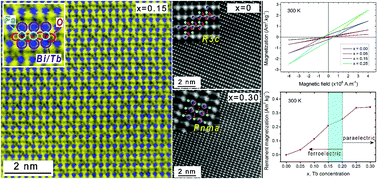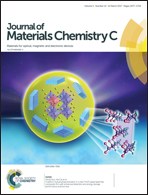Terbium-induced phase transitions and weak ferromagnetism in multiferroic bismuth ferrite ceramics†
Abstract
Partial substitution of isovalent rare-earth ions for bismuth is one of the most effective ways to develop room temperature BiFeO3-based multiferroic materials with high resistivity and strong magnetoelectric coupling. However, their structures and properties are composition and processing sensitive, with the underlying mechanisms still far from being completely understood. Here we report on the structural, thermal and magnetic properties of polycrystalline Bi1−xTbxFeO3 (0 ≤ x ≤ 0.30) dense ceramics prepared by spark plasma sintering (SPS). The X-ray diffraction study reveals that increasing terbium content induces a structural transformation from the parental rhombohedral (R3c) polar phase to an orthorhombic (Pnma) non-polar phase at x ≈ 0.20–0.25. Complementary Raman and energy-loss near-edge structure (ELNES) spectroscopy studies indicate that the transition proceeds by the progressive loss of Bi–O hybridization. Suppression of the long-range ferroelectric ordering upon Tb substitution and loss of ferroelectricity at x ≥ 0.25 was also confirmed by differential scanning calorimetry. High-sensitivity magnetic measurements show that the introduction of a small amount of Tb3+ ions at the A-sites of the perovskite structure gives rise to the occurrence of spontaneous magnetization at room temperature. The reduced degree of Fe 3d–4p orbital mixing and the weaker Fe 3d–O 2p hybridization, revealed by ELNES and X-ray near-edge absorption fine structure (NEXAFS) analyses, suggest that the substitution-induced changes in the electronic structure are responsible for the enhanced magnetization in Tb-doped BiFeO3. Among the biphasic (R3c + Pnma) compositions with ferroelectric order, the Bi0.8Tb0.2FeO3 compound shows the highest value of remanent magnetization (Mr ≈ 0.26 emu g−1), which makes this material a potential candidate for magnetoelectric applications.



 Please wait while we load your content...
Please wait while we load your content...